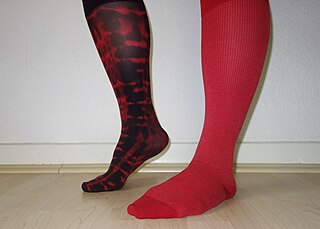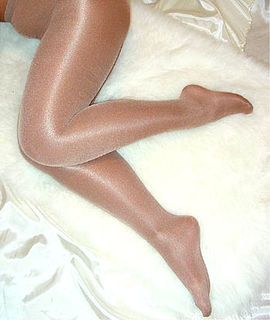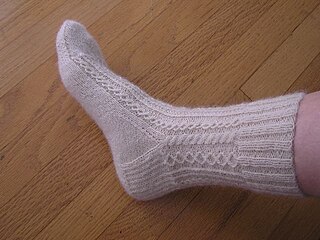 W
WHosiery, also referred to as legwear, describes garments worn directly on the feet and legs. The term originated as the collective term for products of which a maker or seller is termed a hosier; and those products are also known generically as hose. The term is also used for all types of knitted fabric, and its thickness and weight is defined by denier or opacity. Lower denier measurements of 5 to 15 describe a hose which may be sheer in appearance, whereas styles of 40 and above are dense, with little to no light able to come through on 100 denier items.
 W
WA bootee is a short soft sock or bootlike garment used for warmth or protection. Bootees for babies are usually thick and knitted, to keep the baby's feet warm. Dog booties for dogs such as sledge dogs in very cold Arctic conditions protect the animal from the cold. Booties worn over the shoes in cold-weather biking similarly protect cyclists.
 W
WBoothose are over-stockings or boot liners worn in the sixteenth and seventeenth centuries to protect fine knitted stockings from wear. They first appear around 1450.
 W
WCompression garments are pieces of clothing that fit tightly around the skin. In medical contexts, compression garments provide support for people who have to stand for long periods or have poor circulation. These come in varying degrees of compression, and higher degree compression sleeves, such as sleeves that provide compression of 20–30 mmHg or higher, typically require a doctor's prescription. Compression garments worn on the legs can help prevent deep vein thrombosis and reduce swelling, especially while traveling.
 W
WCompression stockings are a specialized hosiery designed to help prevent the occurrence of, and guard against further progression of, venous disorders such as edema, phlebitis and thrombosis. Compression stockings are elastic compression garments worn around the leg, compressing the limb. This reduces the diameter of distended veins and increases venous blood flow velocity and valve effectiveness. Compression therapy helps decrease venous pressure, prevents venous stasis and impairments of venous walls, and relieves heavy and aching legs.
 W
WDurham Hosiery Mill No. 15, also known as Mebane Yarn Mills, Inc. and Rockfish-Mebane Yarn Mills, Inc., is a historic hosiery mill building located at Mebane, Alamance County, North Carolina. It was built in 1922, and is a two-story, 20-bay, cast-in-place concrete mill building. Two-story concrete pilasters define each window bay. It features a centrally-placed, two-story, projecting square tower. A nine bay addition was built in 1966. The mill closed in 2001.
 W
WIn the field of textiles, fishnet is hosiery with an open, diamond-shaped knit; it is most often used as a material for stockings, tights, gloves or bodystockings. Fishnet is available in a multitude of colors, although it is most often sported in traditional matte black. Fishnet is commonly worn on the legs and arms by practitioners of goth and punk fashion, but is also commonly worn by the mainstream as a fashion statement. Generally considered to be a sexy garment, it may serve as a component of sexual fetishism typically done by men. Fishnets are used mostly as a type of undergarment, and in as much as it defines curves by applying a grid close to the body it generally accentuates the wearer's muscular definition.
 W
WA fluffy, also known as a furry leg warmer or furry boot cover, is a form of footwear fashion accessory. It is a form of leg warmer normally made out of faux fur that covers the user's main footwear. It is most normally associated with the rave scene and cybergoth fashion. Fluffies originated in the rave scene in mid-to-late 1990s Ibiza, where they worn by podium dancers during their performances.
 W
WFully fashioned stockings (FFS), are stockings with characteristic reinforcements on the heel and top, a so-called keyhole at the back of the top, and a stitched back seam in between. They are made to be worn with a garter belt and are today considered a vintage design of hosiery after largely having been replaced by seamless stockings and pantyhose from the 1960s onwards. Fully fashioned stockings are usually made from nylon and thus have very little stretch compared with modern stockings and pantyhose.
 W
WA garter is an article of clothing comprising a narrow band of fabric fastened about the leg to keep up stockings. In the eighteenth to twentieth centuries, they were tied just below the knee, where the leg is most slender, to keep the stocking from slipping. The advent of elastic has made them less necessary from this functional standpoint, although they are still often worn for fashion. Garters have been widely worn by men and women, depending on fashion trends.
 W
WHold-ups or stay-ups are stockings with an elasticized band at the top, designed to hold the stockings up when worn, without the use of a garter belt or garters. Thigh highs are held up by one or more bands sewn to the top that is backed with silicone on its inner surface. This ensures the thigh highs stay in position because of the elastic and the friction of the silicone against the skin. The silicone can become ineffective by contact with body lotions, oils and talcum powder, as they all reduce the friction of the silicone. Thigh highs are designed so that the elastic band exerts just the right pressure on a woman's thigh, avoiding any uncomfortable tightness or unflattering muffin-top effect. Sometimes thigh highs are preferred to pantyhose for hygiene reasons, because they reduce excessive microbial growth around the groin due to humidity and warmth.
 W
WHose are any of various styles of men's clothing for the legs and lower body, worn from the Middle Ages through the 17th century, when the style fell out of use in favour of breeches and stockings. The old plural form of "hose" was hosen. In German these terms remained in use and are the generic terms for trousers today. The French equivalent was chausses.
 W
WJorabs are multicolored socks with intricate patterns, knitted from the toe-up. They are usually worn in such a way as to display rich decoration.
 W
WKnee highs are hosiery that cover the feet and legs up to the knee. A fashion accessory for casual and classic cool or warm weather apparel. Typically worn by women in many societies, they are sometimes worn with modern semi-formal attire. Unlike ordinary socks, they are generally made of nylon or other stocking materials. There were also different types and uses of knee highs for men.
 W
WLansdale Silk Hosiery Compy-Interstate Hosiery Mills, Inc. is a historic silk mill complex located at Lansdale, Montgomery County, Pennsylvania. It was built in four interconnected phases between 1922 and 1961, with the original 1922 building, as well as the 1932 building, included in the listing. The original building was built in 1922, with additions constructed in 1926, 1928, and 1929. The building is two stories tall, and sits on a brownstone foundation. The 1932 building is a three-story, red brick building with a flat roof and brick parapet. The complex produced women's full-fashioned silk hosiery. It was occupied by textile manufacturers into the 1970s.
 W
WLeg warmers are coverings for the lower legs, similar to socks but thicker and generally footless. Leg warmers are worn to keep the lower legs warm in colder weather. They can be tubular sleeves, long fabric wrappings, or simple pieces of fur or fabric tied around the calves. They are used in several outdoor activities and sports including cycling, soccer, hockey, hiking, ice skating, and dance.
 W
WLeggings refer to several types of leg coverings. Modern usage from the 1960s has come to refer to elastic close-fitting garments worn over the legs typically by women, such as leg warmers or tights. Usage from the 18th century refers to men's wear, usually made of cloth or leather that is wrapped around the leg down to the ankle. In the 19th century, leggings usually referred to infants' leg clothing that were matched with a jacket, as well as leg-wrappings made of leather or wool and worn by soldiers and trappers. Leggings prominently returned to women's fashion in the 1960s, drawing from the form-fitting clothing of dancers. With the widespread adoption of the synthetic fibre Lycra and the rise in popularity of aerobics, leggings came to further prominence in the 1970s and '80s, and eventually made their way into streetwear. Leggings are a part of the late 2010s athleisure fashion trend of wearing activewear outside sporting activities and in casual settings.
 W
WA leotard is a unisex skin-tight one-piece garment that covers the body from the crotch to the shoulder. The garment was made famous by the French acrobatic performer Jules Léotard (1838–1870). There are sleeveless, short-sleeved, and long-sleeved leotards. A variation is the unitard, which also covers the legs.
 W
WThe nylon riots were a series of disturbances at American stores created by a nylon stocking shortage.
 W
WPantyhose, called sheer tights, or sheers in the United Kingdom and a few other countries, are close-fitting legwear covering the wearer's body from the waist to the toes. Mostly considered to be a garment for women and girls, pantyhose first appeared on store shelves in 1959 as a convenient alternative to stockings and/or control panties.
 W
WA sock is a piece of clothing worn on the feet and often covering the ankle or some part of the calf. Some type of shoe or boot is typically worn over socks. In ancient times, socks were made from leather or matted animal hair. In the late 16th century, machine-knit socks were first produced. Until 1800 both hand knitting and machine knitting were used to produce socks, but after 1800, machine knitting became the predominant method.
 W
WStockings are close-fitting, variously elastic garments covering the leg from the foot up to the knee or possibly part or all of the thigh. Stockings vary in color, design, and transparency. Today, stockings are primarily worn for fashion and aesthetics, usually in association with mid-length or short skirts.
 W
WTights are a kind of cloth garment, most often sheathing the body from the waist to the toe tips with a tight fit, hence the name. They come in absolute opaque, opaque, sheer and fishnet styles — or a combination, such as the original concept of the American term pantyhose with sheer legs and opaque panty.
 W
WTreggings are leggings styled to look like trousers. Much like jeggings, treggings is a portmanteau of trousers and leggings.
 W
WThe W. B. Davis Hosiery Mill is a historic industrial complex in Fort Payne, Alabama. The mill opened in 1884, in the midst of Fort Payne's economic boom, manufacturing building hardware & supplies. The main building, which features Colonial Revival details, is three stories tall, and 12-over-12 sash windows on each floor. An 85-foot (26-meter) chimney has a flared top and corbeled brick course, imitating a doric order column. By 1890, promises of plentiful and high-quality iron ore and other minerals were proven to be exaggerated. Eight of the largest manufacturers in town merged in a failed effort to avoid bankruptcy.